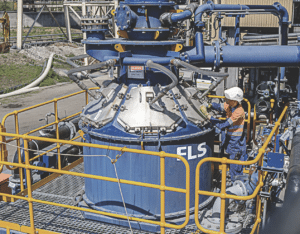As the mining industry navigates the clean-energy transition, FLS calls on miners to take a pause to optimise operations.
The mining industry must be adaptable if it hopes to thrive in a time of heightened sustainability and environmental demands, according to FLS Asia Pacific regional president Jason Elks.
Elks spoke to Australian Mining about the need for operational transformation to meet environmental, social, and governance (ESG) expectations and remain competitive in a market increasingly influenced by carbon regulation.
“Corporate governance and ESG compliance are no longer optional; boards understand this because legislation mandates it,” Elks said.
“However, many companies still prioritise increasing production year over year, which conflicts with the need to pause and reconfigure operations to be more sustainable.”
Elks believes this reluctance stems from a risk-averse mindset.
“People want to do what they did yesterday because it’s a known quantity,” he said.
“But you can’t make operations greener by sticking to old methods.
“To achieve real change, there must be a willingness to stop, rethink, and reconfigure.”
Case for pausing operations
Elks pointed out that implementing greener technologies sometimes requires a temporary halt in production.
This pause is often seen as an insurmountable challenge, but Elks argued that the long-term benefits far outweigh the short-term disruption.
“Imagine stopping operations for a few weeks to adopt new technology that could generate an additional 10 million tonnes of output annually, equating to $1 billion in revenue,” he said.
“In some cases, like with manganese operators using our technology, the payback period is as short as three and a half weeks.”
This quick return on investment highlights the financial and environmental benefits of embracing new solutions.
Improving existing operations
FLS has shifted its approach from merely selling equipment to becoming a partner in optimising mining operations.

Image: FLS
The company offers audits to identify inefficiencies and opportunities for improvement, often uncovering substantial gains with minimal investment.
“We’re not just here to sell you a crusher,” Elks said. “We want to partner with your team to optimise your entire operation.
“In one case, we identified changes that could increase output by four per cent, translating to an additional $148.5 million annually. And our audit cost the client a fraction of that.”
This collaborative approach addresses a significant disconnect in the industry: the lack of communication and knowledge-sharing across the supply chain.
Elks said many operators and procurement teams fail to grasp the long-term financial impact of efficiency gains, focusing instead on upfront costs.
“A lot of procurement decisions are made by people who don’t fully understand the equipment’s potential,” he said.
“They’ll haggle over a five per cent discount without realising that a 2–3 per cent efficiency improvement could add billions of dollars to revenue.”
Assisting in the transition
FLS is helping companies navigate these changes by providing the expertise and technology needed to reduce emissions and improve efficiency.
For example, the company’s REFLUX technologies, developed over a decade ago, have demonstrated significant environmental and economic benefits.
“We can reduce CO2 emissions in iron ore production by 12 per cent today, using existing technology,” Elks said.
“That not only lowers tax liabilities but also creates a greener product that can command a premium.”
FLS’ premium fixed plant offerings include its REFLUX Classifier (RC), REFLUX Concentrating Classifier (RCC), and REFLUX Flotation Cell (RFC).
These innovations are complemented by a comprehensive range of crushing, milling, and grinding solutions, providing robust and efficient processing systems for the mining industry.
The RC has earned a reputation as one of the most advanced fine-particle, gravity-based separation technologies on the market.

Image: FLS
Engineered for minimal power and water consumption, the RC maximises mineral recovery while reducing operational costs. This efficiency is crucial for mining operations striving to optimise productivity without compromising sustainability.
The RCC and RFC extend the capabilities of REFLUX technology, offering enhanced separation and flotation performance. The RCC delivers sharper particle separations, while the RFC delivers high throughput and low energy consumption, addressing some of the most pressing challenges in mineral processing.
These technologies form a core component of FLS’ MissionZero strategy, an ambitious initiative aimed at helping mining customers achieve zero emissions, zero water waste, and zero energy waste by 2030.
By partnering with customers through a holistic, end-to-end solutions model, FLS delivers sustainable and scalable systems that drive operational efficiency and environmental stewardship.
With a proven track record of innovation and a commitment to mining’s future, FLS’ REFLUX technologies are paving the way for a greener, more efficient mining sector, making them an indispensable choice for forward-thinking mining operators.
Call to action
The industry is being urged to think beyond short-term gains and consider the broader impact of their decisions.
By fostering long-term partnerships that prioritise sustainability and profitability, FLS empowers its mining partners to work intelligently and proactively, considering the medium- and long-term opportunities rather than only operating in the now.
“We want to educate the entire supply chain, from operators to corporate teams, on the value of investing in smarter, greener technologies,” Elks said.
“The solutions are already here – we just need the industry to embrace them.
“Money is irrelevant compared to time – the longer we wait to implement these solutions, the greater the cost to the industry.”
In a world with greater levels of environmental obligation and legislation, change is becoming mandatory rather than optional, and mining companies without change management processes in place risk being left behind.
This feature appeared in the February 2025 issue of Australian Mining.



